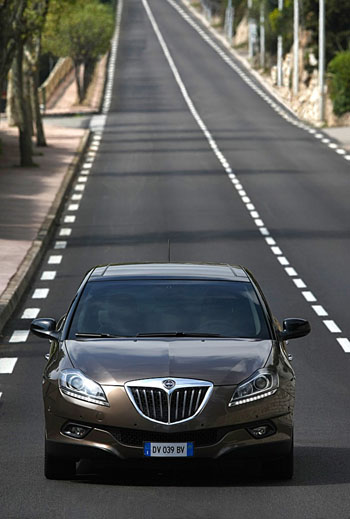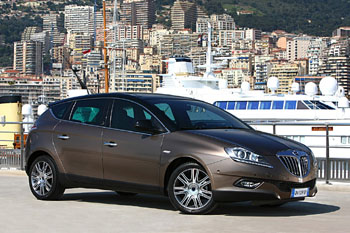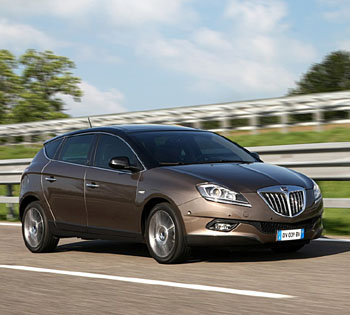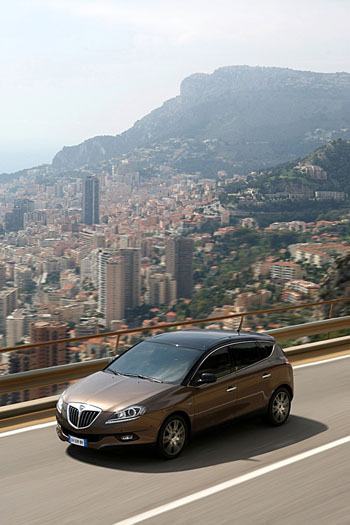|
Systems and technologies of the
latest
generation
|
|
Though sticking with
the Lancia
traditions, the
Delta model makes a
significant step
forward in terms of
technological
innovations applied
to dynamic driving,
safety and comfort.
The best example of
this is the adoption
of last generation
systems and devices
- some introduced
for the first time
in this range of
cars - capable of
making any trip,
even the shortest
one, very pleasant.
Here are three great
features now
available in the
Lancia Delta range.
Sportronic: 6 gear
automatic
transmission
The combination of
the 200 HP 1.8 Di
TurboJet with a 6
gear automatic
transmission
enhances even
further the
flexibility and
prompt reaction of
this car, making
changing gear in
Lancia Delta very
fluid, responding to
client requirements
and adapting both to
a comfortable and to
a sports drive.
In particular, the
transmission stands
out for being light
and compact as well
as being designed to
reduce fuel
consumption: on one
hand, the use of low
friction oil has
enabled the
designers to improve
the engine's
efficiency; on the
other hand, the
introduction of a
sixth gear makes
driving on a
motorway much
easier. The accurate
management software
assesses different
road conditions and
adapts the
driveability to them
through a set of
functions such as:
braking assist,
gradient assessment,
bend, sport or
comfort drive.
Lastly, the pleasant
drive is enhanced by
the opportunity to
choose between
“Winter” “Norm” and
“Sport” programs, as
well as the manual
setting (TIP). The
controls placed on
the steering wheels
make Delta a real
sports car.
Electronic
suspensions with
variable damping
system (Reactive
Suspension System)
The suspension's
layout adopted by
Lancia Delta is
based on an
established
architecture which
was optimised in
terms of comfort and
lightness: the front
suspension is a
MacPherson with
mechanic crossmember
and track control
arms optimised for
the new load
conditions. A
solution of
torsional axle and
anti-roll bar was
chosen for the rear
axle in order to
achieve excellent
drive performances.
But the great
innovation of this
model is represented
by the introduction
of a feature
realised with the
help of Magneti
Marelli: the
innovative
oscillation damping
system (Reactive
Suspension System)
which up to now had
been used only in
high range cars and
which now Fiat Group
has decided to use
for the first time
ever in a medium
range car. In
detail, the Reactive
Suspension System -
using real time
electronic control
of the shock
absorbers - reduces
car oscillations in
all driving
conditions. In this
way, higher levels
of safety, comfort
and driveability are
guaranteed. Thanks
to some sensors, the
system assesses
driving and road
surface conditions
and then selects the
most appropriate
control settings.
Among these, there
is a function called
“Sky-Hook” which
enables to isolate
the passenger
compartment making
it stress-free.
Furthermore, thanks
to the high
calculation capacity
of the electronic
control unit and the
instant and accurate
response of the
solenoid valves, the
system neutralises
all disturbances
caused by the
irregular road
surface and allows
excellent dynamic
control even for a
sports drive
(selectable) by
increasing steering
manageability and
control.
|

 |
|

 |
|
Last but not
least, the “Reactive Suspension System” reduces the braking
distance (by about five percent thanks to a
perfect ground/wheel
contact) and
thus guarantees a prompt
reaction in the
event of an
emergency manoeuvre
with, as a
consequence, easy
recovery of the
safety conditions.
Semi-automatic
parking support
system (Magic
Parking)
Looking for a
parking space is
often a difficult
task, especially in
cities with heavy
traffic. Besides,
once you find a
space, parking can
be quite difficult
given the lack of
available room. For
this reason, Lancia
Delta is provided
with an innovative
parking support
system which helps
the driver first to
identify a good
parking spot and
then to make the
right parking
manoeuvres. First of
all, the system
measures the length
of the space and
informs the driver
whether this length
is sufficient to
park the car.
Then the system
enables the car to
steer automatically
once the reverse
gear is engaged. In
this way, the only
thing the driver
must do is regulate
the speed of the car
by using the
accelerator and
brake pedals.
The driver can park
his/her car in a
parallel parking
space with only one
manoeuvre. In this
way, the available
free room is
optimised and the
number of manoeuvres
required to park the
car minimised.
Obviously, the
driver has full
control of the
entire operation by
operating the pedals
and can de-activate
the system at any
time by regaining
control of the
steering wheel or by
moving out of
reverse gear or,
alternatively, by
pressing the
dedicated button.
More in details, the
radar sensor
installed on the
right and left hand
side of the car, on
the inside of the
front bumper, is at
the core of this
system. A radar beam
is shone to the
right (or left) and
the echoes are
picked up by the
sensor which then
reconstruct the map
of the area between
the parked cars,
"sees" any available
space and identifies
possible obstacles.
At the same time, by
analysing the wheel
speed, the system is
able to measure the
length of free
areas.
Should the measured
length be compatible
with the size of the
car plus 130 cm (65
cm in front and 65
cm at the back),
with a total car
space length of at
least 5.82 m, the
driver is then
informed of the
presence of a
suitable parking
space. An acoustic
alarm signals the
presence of the
parking space and,
at the same time,
the display shows
the number of
manoeuvres required
to park.
If the driver
considers the
identified parking
space as suitable
and engages the
reverse gear, the
system takes
automatic control of
the side dynamic of
the car through the
electric steering by
allowing the driver
to remove his/her
hands from the
steering wheel and
control the movement
exclusively by
operating the
accelerator and
brake pedals. In
this phase, the
maximum allowed
speed is 7 km/h. To
turn system off it
is enough to regain
control of the
steering wheel. |
|